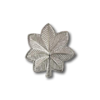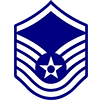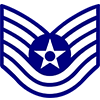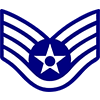-
Lieutenant Colonel
 O-5 | LTC
O-5 | LTCThe Lieutenant Colonel has proven himself as the Regimental Executive Officer, serving at the Commanding Officer's right hand, and even in his stead when necessary. The LTC, as Executive Officer, oversees all day to day operations and activities of the Regiment at the direction of the Commanding Officer. His is a trusted and wise voice in the Command Staff as well, always assisting his Company Commanders and other junior officers.
-
Major
 O-4 | MAJ
O-4 | MAJThe Major is a Field Grade officer, one who is proven at all levels and can now be trusted with responsibilities that span the whole Regiment. The Major can serve as the Battalion Commander, Regimental Staff Officer, or even Regimental Executive Officer. All eyes are on the Major, for he assists the leadership of the Regiment in all areas.
-
Captain
 O-3 | CPT
O-3 | CPTTo be promoted to Captain is to be the standard of excellence as a Company Commander and an Officer. The Captain enjoys universal respect from his soldiers and fellow Officers and has made the Regiment a better place because his Company has been made ever stronger.
-
First Lieutenant
 O-2 | 1LT
O-2 | 1LTThe First Lieutenant has proven him/herself as a competent Platoon Leader. He has earned the confidence of his soldiers and continues to improve his Platoon, Company and the Regiment as a whole.
-
Second Lieutenant
 O-1 | 2LT
O-1 | 2LTAs the PV2 is the junior soldier and the CPL is the junior NCO, the Second Lieutenant is a junior Commissioned Officer, learning what it means to no longer wear stripes. Second Lieutenants are freshly minted Platoon Leader, and do well to take heed the advise of their Platoon Sergeant & First Sergeants. They also have a seat at the table of Command Staff, but also do well to listen more than speak.
-
Major
 O-4 | Maj
O-4 | MajThe Major is a Field Grade officer, one who is proven at all levels and can now be trusted with responsibilities that span the whole Regiment. The Major can serve as the Battalion Commander, Regimental Staff Officer, or even Regimental Executive Officer. All eyes are on the Major, for he assists the leadership of the Regiment in all areas.
-
Captain
 O-3 | Capt
O-3 | CaptTo be promoted to Captain is to be the standard of excellence as a Company Commander and an Officer. The Captain enjoys universal respect from his soldiers and fellow Officers and has made the Regiment a better place because his Company has been made ever stronger.
-
1st Lieutenant
 O-2 | 1st Lt
O-2 | 1st LtThe First Lieutenant has proven him/herself as a competent Platoon Leader. He has earned the confidence of his soldiers and continues to improve his Platoon, Company and the Regiment as a whole.
-
2nd Lieutenant
 O-1 | 2d Lt
O-1 | 2d LtAs the PV2 is the junior soldier and the CPL is the junior NCO, the Second Lieutenant is a junior Commissioned Officer, learning what it means to no longer wear stripes. Second Lieutenants are freshly minted Platoon Leader, and do well to take heed the advise of their Platoon Sergeant & First Sergeants. They also have a seat at the table of Command Staff, but also do well to listen more than speak.
-
Officer Candidate
 E-5 | OCS
E-5 | OCSOfficer Candidate School (OCS) is the U.S. Army's main training academy for prospective Army Officers. The school is generally open to qualified enlisted non-commissioned officers. Candidates who successfully complete the training and selection, receive formal commissions as U.S. Army Officers and assume the ability to command Soldiers.
-
Chief Warrant Officer 5
 W-5 | CW5
W-5 | CW5Master-level technical and tactical experts that support brigade, division, corps, echelons above corps, and major command operations. They provide leader development, mentorship, advice, and counsel to WOs and branch officers. CW5s have special WO leadership and representation responsibilities within their respective commands.
-
Chief Warrant Officer 4
 W-4 | CW4
W-4 | CW4Senior-level experts in their chosen field. They primarily support battalion, brigade, division, corps, and echelons above corps operations. CW4s typically have special mentorship responsibilities for other WOs and provide essential advice to commanders on WO issues.
-
Chief Warrant Officer 3
 W-3 | CW3
W-3 | CW3Advanced-level experts who perform the primary duties that of a technical and tactical leader. They provide direction, guidance, resources, assistance, and supervision necessary for subordinates to perform their duties. CW3s primarily support operations levels from team or detachment through brigade.
-
Chief Warrant Officer 2
 W-2 | CW2
W-2 | CW2Chief Warrant Officers become commissioned officers by warrant as determined by the President of the United States. Chief Warrant Officers are intermediate level technical and tactical experts who perform increased duties and responsibilities at the detachment through battalion levels.
-
Warrant Officer Candidate
 E-5 | WOC
E-5 | WOCAviation Center of Excellence (Aviation School) is the U.S. Army's main training academy for prospective Warrant Officers. The school is generally open to qualified enlisted personnel. Candidates who successfully complete the rigorous training curriculum receive formal commissions as U.S. Army Warrant Officers.
-
Warrant Officer 1
 W-1 | WO1
W-1 | WO1Appointed by warrant from the Secretary of the Army, Warrant Officer 1's are technically and tactically focused officers who perform the primary duties of technical leader, trainer, operator, manager, maintainer, and adviser.
-
Master Sergeant.
 E-7 | MSgt
E-7 | MSgtIs the highest achievable enlisted rank within TACP, they are the most experienced member on the team and able to handle any situation thrown at them. They are trusted advisors not only to the detachment ALO but to the Infantry Ground Commander.
-
Technical Sergeant
 E-6 | TSgt
E-6 | TSgtServe's as the senior TACP Airman on the team. They are reliable leaders able to direct and train the TACP, as well as advise the ALO.
-
Staff Sergeant.
 E-5 | SSgt
E-5 | SSgtThe first NCO rank within TACP and have shown through their experience as a combat controller they are capable to operate independently and lead the TACP when called upon. They continue to train the junior enlisted and are considered the “working level” TACP.
-
Senior Airman
 E-4 | SrA
E-4 | SrAHas shown improvement and proficiency upon joining TACP, they have participated in operations and proven themselves as an asset.
